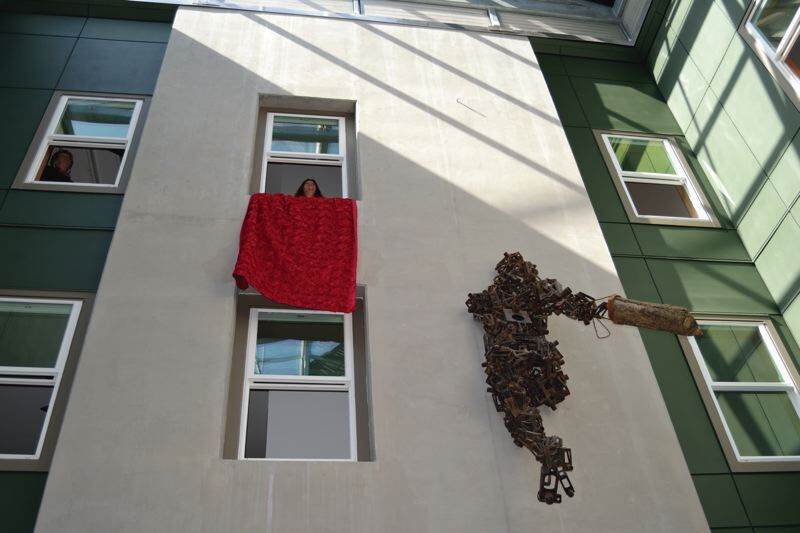Old Town’s Erickson Fritz apartments get $15.9 million rehab
Published 12:00 am Tuesday, August 4, 2015

- During the art unveiling, a woman sings from a second-floor window adorned with red velvet drapery near the iron element Sasquatch art attached to the wall, representing running away from the settlers impact on the ecosystem.
Artists rolled a tarp across the skylight, darkening the courtyard as a woman sang from a second-floor window.
Trending
Two couples dressed to represent the early 1900s with top hats and long gloves waltzed around the floor before the woman sang from the window again and the tarp was pulled back from the skylight, representing morning.
“I view it as an opera with characters,” said James Harrison, the lead artist on the interactive art project unveiled last Thursday at the grand opening of the new $15.9 million remodel of the Erickson Fritz Apartments in Old Town.
“The narrative is embedded in the pieces, but it’s not going to hit you over the head,” he said.
Trending
Harrison is the lead on a team of five Portland-based artists, including David Laubenthal and Natalie Ball, historian Doug Kenck-Crispin, and carpenter Evan Holt.
The group created an art series to adorn the courtyards at the mixed-income Erickson Fritz Apartments, at Southwest Second Avenue and Burnside Street.
The building recently was remodeled from an 1880s saloon into affordable, low-income housing.
Northwest Portland-based Innovative Housing Inc. — a real estate developer that helps build low-income homes near jobs, the city and transit — hosted the grand opening and “friendraiser,” a benefit that raised $50,000 by the end of the evening to support their mission.
According to Kenck-Crispin, the historian on the art project, Erickson’s Saloon was the place to go for bootleg beer during Prohibition, passed in Oregon in 1916, that customers would sneak up to their rooms.
“The mythology surrounding these buildings made it all the more fun to restore the beauty and architectural detail that once made (original building owner) August Erickson so proud,” said Sara Stevenson, executive director of Innovative Housing, Inc.
“That same historical weight placed a significant responsibility on our shoulders to do these buildings justice, and to create something truly special here.”
Boasting a 680-foot mahogany bar that eventually ended up a tenth of the size by the end of Prohibition, the second floor was small hotel rooms and the third floor was rooms — “cribs” — barely big enough to fit a mattress.
Eight-foot-high walls topped by chicken wire separated them, rented out for use by prostitutes.
Residents of Old Town, including Chinatown and Japantown, have been forced to move in past decades as the area has gentrified.
Residents who earn 60 percent of the median-area income or less qualify for affordable housing in Portland.
Ball, one of the Portland-based artists on the project, was impacted by gentrification growing up in North Portland. Her grandparents, too, moved from Chiloquin to Vanport during World War II before being displaced by the Vanport flood and again by the I-5 construction in North Portland. “Displacement is not a recent phenomenon for Native and black communities in Portland,” Ball says.
Great cloud-shaped lamps hung from the courtyard skylight at the Erickson Fritz Apartments last week, suspended by electric cords and oars.
A piece of the original bar from the 1880s accompanies a tufted red velvet settee nearby a log bench with a log campfire lamp centerpiece.
“I entered the space to create a piece to acknowledge many other things,” Ball said. “An indigenous history in the area that existed before the building, the original building, those not mentioned or marginalized in the building’s main narrative, and now the newly renovated space and its progressive initiatives.”
@JulesJayRogers







